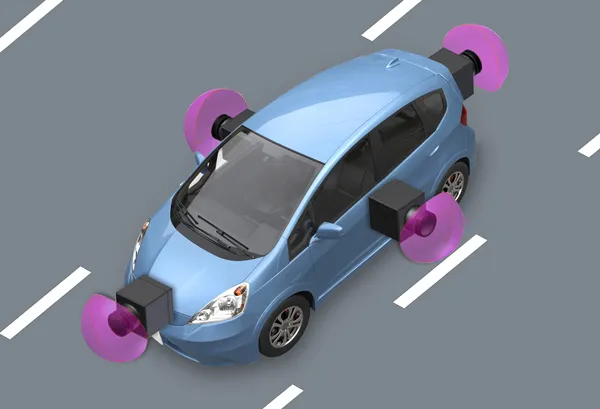Bird's eye view for wheelchair
Background
For my university's capstone project, I was tasked with creating a device
that can help our client in visualizing the surrounding environment while
driving his power wheelchair. Our client suffered from paralysis below the
neck, which meant that his only source of mobility was his power wheelchair.
He specifically needed a device that could assist him in visualizing the
back half of his wheelchair.
Our team took inspiration from the bird's eye view that some car models
provide. The working principle behind the bird's eye view is to use multiple
wide-angle (fisheye) cameras attached to the sides of the car and
computationally combine all video streams to provide a top-down view of the
car.
Although the system does not look too difficult to implement at first, we
quickly realized that making a system that is both durable and reliable for
long-term use while being attached to a moving wheelchair was extremely
difficult. Thus, we decided to divide the team into different sub teams. I was
in charge of leading the software engineering sub team, which handled the code
behind processing the video frames and combining them into a single bird's eye
view.
The purpose of this blog post is to explain the detailed inner workings of the
GUI application that my sub team developed.
Implementation
Because our client could see in front of him, we decided that installing 3 cameras at the left, right, and back sides of the wheelchair was sufficient.
Gazebo model used for simulation
The image processing pipeline is undistortion --> projection -->
combination. The raw image frames from each camera goes through all three
steps to produce the bird's eye view.
Undistortion
Wide-angle cameras have the benefit of being able to capture a wider field of
view, but they come with the cost of producing heavily distorted images.
Gazebo's camera plugin
Gazebo's wide-angle camera plugin (180 degree field of view)
(The two cameras are the same distance away from the object)
The reason for using a wide-angle camera instead of a pinhole camera, which
has much less distortion, is because pinhole cameras do not provide the field
of view required to make the bird's eye view.
Overlapping fields of view highlighted in red
The fields of view of the cameras need to overlap to produce a continuous view
of the surroundings.
Hence, the first step in the image processing pipeline is undistorting the raw
image frames. This is a fairly simple task using OpenCV's fisheye calibration
module.
Using the cv::findChessboardCorners() function, you can find the corner points
of a chessboard (a corner point is defined as a point of intersection of two
white tiles and two black tiles). The coordinates of these corner points
contain the information about the severity of the distortion and using the
cv::fisheye::calibrate() function, you can find the 4 distortion coefficients
that fully describe the distortion mathematically (details about the math is
at
https://docs.opencv.org/4.x/db/d58/group__calib3d__fisheye.html)
Using the 4 distortion coefficients, cv::fisheye::initUndistortRectifyMap(), and cv::remap(), you can produce the undistorted image frames. Notice that the field of view decreased due to the undistortion process. However, it is still sufficient to produce the bird's eye view.
An important note about computing the distortion coefficients is that the
chessboard must be shown to the camera in as many orientations as possible for
accurate results, which is why I made a moving chessboard in Gazebo.
Projection
The next step in the image processing pipeline is the projecting the image
frames into a top-down view. This means transforming the perspective of the
cameras from a side view into a top-down view. OpenCV provides the functions
cv::getPerspectiveTransform() and cv::warpPerspective() for this specific
task.
The cv::getPerspectiveTransform() function takes in 4 source points and 4
destination points to calculate the 3x3 matrix that describes the intended
perspective transform. The 3x3 matrix can then be fed into the
cv::warpPerspective() function to produce the image frame with transformed
perspective.
Back camera view
Left camera view
Right camera view
Combination
With the projection matrices calculated, the final step is to combine all
projected images into a single bird's eye view. This is a simple process
where you generate a blank image matrix with the specific size that can fit
in all the projected images then drawing the images onto it.














Comments
Post a Comment